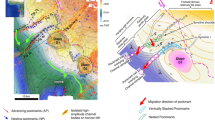Abstract
The Cretaceous north Pyrenean interplate basin developed in conjunction with the opening of the Bay of Biscay with the deposition of large amounts of carbonates on its margins. Major failures of linear segments of the shelf and slope generated autosuspended mass flows; some of these flows differentiated orevolved into megaturbidites that are up to 63 m thick and 95 km long. A study of the evolutionary mass flow-megaturbidites also has application to petroleum geology because it can help to detail the anatomy of a basin and its related distribution of sedimentary bodies and paleoenvironments.
Similar content being viewed by others
References
Argand E (1926) La tectonique de l'Asie. Comptes rendus 13ěme session Congres geologique international, Liège, Belgium, 1:171–372
Le Pichon X, Bonnin J, Francheteau J, Sibuet JC (1971) Une hypothěse d'évolution tectonique du golfe de Gascogne. In: Histoire Structurale du Golge de Gascogne, Technip, Paris, 1 (11), pp 1–44
Bourrouilh R, Doyle LJ (eds) (1985) Interplate margins of the French Pyrenees and Aquitaine Basin. In: Petroleum Geology, Tectonics and Sediments. American Association Petroleum Geologists Field Seminar, Pau, France: 102 pp
Curnelle R, Dubois P, Seguin JC (1982) The Mesozoic-Tertiary evolution of Aquitaine Basin. Philosophic Transactions Royal Society London, A 305:63–84
Deloffre R (1966) Etude géologique du flysch Crétace Supérieur entre les Vallées de l'Ouzom et du Gave de Mauléon. Briěre (édition), Paris, 265 pp
Lagier Y, Souquet P, Debroas E (1982) Mégaturbidites dans le flysch calcaire néo-crétacé des Pyrénées basco-béarnaises. In: 9ěme Réunion annuelle des Sciences de la Terre. Sociéte géologique de France, Paris: 352 pp
Bourrouilh R, Offroy B (1983) Séquences de mass flow évolutif-mégaturbidites du flysch Sénonien nord-pyrénéen. Traitement statistique et anatomie du bassin sénonien. In: Colloque sur le Sénonien, Géologie méditerranéenne, X pp 345–359
Bourrouilh R, Coumes F, Offroy B (1984) Mécanismes séquentiels et évenements exeptionnels du flysch nord-pyrénéen; corrélations par les dépôts gravitaires profonds. Société géologique de France Bulletin 7, XXVI:1223–1234
Offroy B (1984) Approche des mécanismes de sédimentation gravitaire: exemple des dépôts carbonatés des flyschs Cretacé supérieur des Pyrénées atlantiques. Unpublished Thesis, Universite Paris VII, 230 pp
Middleton GV, Hampton MA (1973) Sediment gravity flows: mechanics of flow and deposition. In: Turbidites and Deep Water Sedimentation. Society Economic Paleontologists and Mineralogists, Pacific Section Short Course Anaheim, pp 1–38
Hampton MA (1972) The role of subaqueous debris flow in generating turbidity currents. Journal Sedimentary Petrology 42:775–793
Ravenne C, Beghin P (1983) Apport des expériences en canal a l'interprétation sédimentologique des dépôts de cones détritiques sous-marins. Revue de l'Institut Francais du Pétrole 38:279–297
Labaume P (1983) Evolution tectono-sédimentaire et mégaturbidites du bassin turbiditique éocěne sud-pyrénéen. Unpublished Thesis, Université de Montpellier, 170 pp
Naylor MA (1981) Debris flow (olistostromes) and slumping on a distal passive continental margin: the Palombini limestone-shale sequence of the northern Apennines. Sedimentology 28:837–852
Cossey SPJ, Ehrlich R (1979) A conglomeratics, carbonate flow deposit, northern Tunisia; a link in the genesis of pebbly mudstones. Journal Sedimentary Petrology 49:11–22
Krause FF, Oldershaw AE (1979) Submarine carbonate breccia beds—a depositional model for two-layers, sediment gravity flow from the Sekwi Formation (Lower Cambrian) Mackenzie Mountains, Northwest Territories, Canada. Canadian Journal Earth Sciences 16:189–199
Labaume P, Mutti, E, Seguret, M (1987) Megaturbidites: a depositional model from the Eocene of the SW-Pyrenean Foreland Basin, Spain. Geo-Marine Letter, 7:91–101
Gorsline DS, Emery KO (1959) Turbidity-current deposits in San Pedro and Santa Monica Basins off Southern California. Geological Society American Bulletin 70:269–290
Gorsline DS (1980) Deep water sedimentologic conditions and models. Marine Geology 38:1–12
Field ME, Gardner JW, Jennings AE, Edwards BE (1982) Earthquake induced sediment failures on a 0.25° slope, Klamath River deltas, California. Geology 10:542–546
Author information
Authors and Affiliations
Rights and permissions
About this article
Cite this article
Bourrouilh, R. Evolutionary mass flow-megaturbidites in an interplate basin: Example of the north Pyrenean basin. Geo-Marine Letters 7, 69–81 (1987). https://doi.org/10.1007/BF02237986
Received:
Revised:
Issue Date:
DOI: https://doi.org/10.1007/BF02237986




